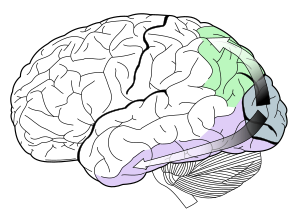視覚経路
稲垣未来男
大阪大学大学院 生命機能研究科
DOI:10.14931/bsd.7790 原稿受付日:2018年5月2日 原稿完成日:2019年4月23日
担当編集委員:藤田 一郎(大阪大学大学院 生命機能研究科)
外界からの光の情報が眼球網膜の視細胞で受容された後、並列的・階層的に視覚情報は処理される。完全に独立ではないにしても、ある程度の機能的なまとまりをもつ視覚情報の流れを視覚経路と呼ぶ。後述のように視覚経路には複数の種類が存在する。ここでは主に霊長類大脳皮質における視覚経路について述べる。
視覚経路とは
外界からの光の情報が眼球網膜の視細胞で受容された後、並列的・階層的に視覚情報は処理される。完全に独立ではないにしても、ある程度の機能的なまとまりをもつ視覚情報の流れを視覚経路と呼ぶ。後述のように視覚経路には複数の種類が存在する。ここでは主に霊長類大脳皮質における視覚経路について述べる。
霊長類大脳皮質の2つの視覚経路
霊長類の高度な視覚能力は、発達した大脳皮質における視覚情報処理による部分が大きい。網膜から大脳皮質への主要な中継部位は視床の外側膝状体であり、この外側膝状体を経由する視覚経路を膝状体系と呼ぶ。この他に上丘などの外側膝状体以外を経由する経路は膝状体外系と呼ばれる(後述)。
続いて、視覚情報は外側膝状体から後頭葉の一次視覚野(V1)へと伝えられる。その後、二次視覚野(V2)に至ると、側頭葉へと向かう視覚経路(腹側視覚経路)と頭頂葉へと向かう視覚経路(背側視覚経路)に分岐する(図1)。
腹側視覚経路は主に外界の物体の形状を認識することに貢献する(what経路)。他方で背側視覚経路は物体の位置を知ること、あるいはその物体に対して正確に手を伸ばすなどの動作に決定的な役割を果たす(where経路、あるいはhow経路)。このような機能分化はサルを対象とした動物実験[1]でも、ヒト脳損傷患者の行動観察[2]からも確認されており、霊長類に一般的に当てはまると考えられる。
腹側視覚経路と背側視覚経路の機能の違いは、経路上の視覚領野における神経細胞の反応特性にも反映されている。腹側視覚経路に属する視覚領野では、形や曲率などの物体形状を構成する要素に対する選択性[3][4][5]に加えて、色、材質感などの表面特徴に対する選択性[6][7][8][9]も観察される。特に腹側視覚経路の最終段階に当たる下側頭皮質では、手や顔などの複雑な視覚刺激に対する選択的な反応が報告されている[10][11]。
背側視覚経路に属する視覚領野では、視覚刺激の運動方向に対する強い選択性[12]やオプティックフローに対する選択性[13]が見られる。
一見すると2つの視覚経路で神経細胞の反応特性が似ている場合でも、機能分化が隠されている場合もある。両眼視差選択性がその例である。大脳皮質の視覚関連領野の多くで両眼視差選択性は報告されているが、詳細な解析によって2つの視覚経路で両眼視差の処理様式の差異が分かってきた[14][15][16]。腹側視覚経路は細かな視差を処理して物体の3次元的な形状を認識することに貢献し、背側視覚経路は大まかな視差を処理して3次元的な外界の知覚に関わると考えられている。ただし、物体の3次元的な形状は正確に手で把握する際に重要であるため、後述のように2つの視覚経路の相互結合を通じて背側視覚経路でも利用されていると考えられる[17]。
2つの視覚経路の違いはそれぞれの最終的な出力先からも読み取れる。腹側視覚経路は記憶に関わる嗅周皮質や海馬へ向けて出力する[18]。また情動に関わる扁桃体へも出力する[19]。このように解剖学的にも腹側視覚経路は物体の形状を認識してその意味や価値を憶えておく機能に関わることが示唆される。背側視覚経路の出力は頭頂葉から前頭葉の運動関連領野へと伝えられること[20][21]から動作との関連は明らかである。
近年の進展
従来の2つの視覚経路の仮説を発展させて、背側視覚経路は2つに分岐すると言う考えが提唱されていたが[20]、近年では3つに分岐するという議論がなされている>[21]。これら3つの経路(頭頂葉-前頭前野経路、頭頂葉-運動前野経路、頭頂葉-内側側頭葉経路)は、それぞれ空間的な作業記憶、視覚にもとづく動作、記憶に関連したナビゲーションに関わる可能性が議論されている。
腹側視覚経路と背側視覚経路は完全に独立しているわけではない。腹側視覚経路の下側頭皮質と背側視覚経路の頭頂葉皮質の間には解剖学的な結合関係が存在する[22]。他にも腹側視覚経路と背側視覚経路の相互的な投射関係は多く知られている[23]。上述の脳損傷患者の行動観察が指し示すように2つの視覚経路の相対的な機能分化は明らかだが、だからと言って完全に独立したものではない。
膝状体系
大脳皮質へと伝わる以前の膝状体系にも並列な処理が存在する。
網膜のミジェット細胞から外側膝状体の小細胞層を経由してV1へと至る小細胞経路(パルボ経路)と、網膜のパラソル細胞から外側膝状体の大細胞層(マグノ経路)を経由してV1へと至る大細胞経路である。
サルを対象とした外側膝状体の局所破壊実験から行動レベルでの機能分化も確認されており[24]、機能的なまとまりをもつ2つの視覚経路である。小細胞経路は高い空間分解能をもつが時間分解能は低く、また、色の情報を伝えることができる。ただし、青い色の処理には網膜のバイストラティファイド細胞と外側膝状体の顆粒細胞層が関わる(コニオ経路)[25]。大細胞経路の空間分解能は低いが時間分解能に優れており、色の情報を伝えない。
大脳皮質に到達すると、小細胞経路と大細胞経路はそれぞれ腹側視覚経路と背側視覚経路に大きく寄与するが、厳密に1対1に対応するわけではなく相対的な寄与の大きさが異なると捉えるのが適切である[24]。
膝状体外系
外側膝状体から大脳皮質へと伝えられる情報は視知覚に貢献する。一方、網膜から外側膝状体以外を経由する膝状体外系の情報もそれぞれ特化した役割を担う。中脳の上丘は眼球運動による視線定位に、視蓋前域は瞳孔対光反射に、副視索系は注視の固定に、視交叉上核は光刺激によるサーカディアンリズムの調整にそれぞれ関与すると考えられている[26]。
大脳皮質V1を交通事故や脳卒中などで損傷すると、損傷した部位に対応する視知覚が損なわれる(皮質盲と呼ばれる)。ただし簡単な視覚刺激の判別が可能な場合もあり、意識的な見えは生じないことから通常の視覚と区別して残存視覚や盲視と呼ばれる[27]。膝状体外系の上丘がこの盲視に重要な役割を果たすと考えられている。視覚経路の機能は完全に決定されているわけではなく、脳損傷のような緊急時には多少の補償機構が働くことを示唆する。
大脳皮質の神経回路は生まれた直後には未成熟で、個体の発達とともに成熟していく。そのため新生児の視覚刺激に対する反応(顔への注視など)には、大脳皮質(膝状体系)ではなく膝状体外系の上丘が関与するという考えがある[28]。
関連項目
参考文献
- ↑ Ungerleider LG, Mishkin M
Two cortical visual systems. In: Analysis of Visual Behavior pp. 549–586.
Ingle DJ, Goodale MA, Mansfield RJW, eds. Cambridge: MIT Press: 1982 - ↑
Goodale, M.A., Meenan, J.P., Bülthoff, H.H., Nicolle, D.A., Murphy, K.J., & Racicot, C.I. (1994).
Separate neural pathways for the visual analysis of object shape in perception and prehension. Current biology : CB, 4(7), 604-10. [PubMed:7953534] [WorldCat] [DOI] - ↑
Kobatake, E., & Tanaka, K. (1994).
Neuronal selectivities to complex object features in the ventral visual pathway of the macaque cerebral cortex. Journal of neurophysiology, 71(3), 856-67. [PubMed:8201425] [WorldCat] [DOI] - ↑
Pasupathy, A., & Connor, C.E. (2001).
Shape representation in area V4: position-specific tuning for boundary conformation. Journal of neurophysiology, 86(5), 2505-19. [PubMed:11698538] [WorldCat] [DOI] - ↑
Yamane, Y., Carlson, E.T., Bowman, K.C., Wang, Z., & Connor, C.E. (2008).
A neural code for three-dimensional object shape in macaque inferotemporal cortex. Nature neuroscience, 11(11), 1352-60. [PubMed:18836443] [PMC] [WorldCat] [DOI] - ↑
Balikdjian, D., Regnier, R., Lustman-Marechal, J., De Gandt, J.B., & Baleriaux-Waha, D. (1978).
[Importance of computerized axial tomography and of computerized dosimetry in the treatment of tumors of the facial structures]. Intérêt de la tomographie axiale computée et de la dosimétrie par ordinateur dans le traitement des tumeurs du massif facial. Acta oto-rhino-laryngologica Belgica, 32(2), 124-31. [PubMed:676719] [WorldCat] - ↑
Komatsu, H., Ideura, Y., Kaji, S., & Yamane, S. (1992).
Color selectivity of neurons in the inferior temporal cortex of the awake macaque monkey. The Journal of neuroscience : the official journal of the Society for Neuroscience, 12(2), 408-24. [PubMed:1740688] [WorldCat] - ↑
Nishio, A., Goda, N., & Komatsu, H. (2012).
Neural selectivity and representation of gloss in the monkey inferior temporal cortex. The Journal of neuroscience : the official journal of the Society for Neuroscience, 32(31), 10780-93. [PubMed:22855825] [PMC] [WorldCat] [DOI] - ↑
Okazawa, G., Tajima, S., & Komatsu, H. (2015).
Image statistics underlying natural texture selectivity of neurons in macaque V4. Proceedings of the National Academy of Sciences of the United States of America, 112(4), E351-60. [PubMed:25535362] [PMC] [WorldCat] [DOI] - ↑
Gross, C.G., Bender, D.B., & Rocha-Miranda, C.E. (1969).
Visual receptive fields of neurons in inferotemporal cortex of the monkey. Science (New York, N.Y.), 166(3910), 1303-6. [PubMed:4982685] [WorldCat] [DOI] - ↑
Gross, C.G., Rocha-Miranda, C.E., & Bender, D.B. (1972).
Visual properties of neurons in inferotemporal cortex of the Macaque. Journal of neurophysiology, 35(1), 96-111. [PubMed:4621506] [WorldCat] [DOI] - ↑
Zeki, S.M. (1974).
Functional organization of a visual area in the posterior bank of the superior temporal sulcus of the rhesus monkey. The Journal of physiology, 236(3), 549-73. [PubMed:4207129] [PMC] [WorldCat] [DOI] - ↑
Tanaka, K., & Saito, H. (1989).
Analysis of motion of the visual field by direction, expansion/contraction, and rotation cells clustered in the dorsal part of the medial superior temporal area of the macaque monkey. Journal of neurophysiology, 62(3), 626-41. [PubMed:2769351] [WorldCat] [DOI] - ↑
Parker, A.J. (2007).
Binocular depth perception and the cerebral cortex. Nature reviews. Neuroscience, 8(5), 379-91. [PubMed:17453018] [WorldCat] [DOI] - ↑
Fujita, I., & Doi, T. (2016).
Weighted parallel contributions of binocular correlation and match signals to conscious perception of depth. Philosophical transactions of the Royal Society of London. Series B, Biological sciences, 371(1697). [PubMed:27269600] [PMC] [WorldCat] [DOI] - ↑
Janssen, P., Verhoef, B.E., & Premereur, E. (2018).
Functional interactions between the macaque dorsal and ventral visual pathways during three-dimensional object vision. Cortex; a journal devoted to the study of the nervous system and behavior, 98, 218-227. [PubMed:28258716] [WorldCat] [DOI] - ↑
Sakata, H., Taira, M., Kusunoki, M., Murata, A., & Tanaka, Y. (1997).
The TINS Lecture. The parietal association cortex in depth perception and visual control of hand action. Trends in neurosciences, 20(8), 350-7. [PubMed:9246729] [WorldCat] [DOI] - ↑
Suzuki, W.A., & Amaral, D.G. (2004).
Functional neuroanatomy of the medial temporal lobe memory system. Cortex; a journal devoted to the study of the nervous system and behavior, 40(1), 220-2. [PubMed:15070014] [WorldCat] [DOI] - ↑
Aggleton, J.P., Burton, M.J., & Passingham, R.E. (1980).
Cortical and subcortical afferents to the amygdala of the rhesus monkey (Macaca mulatta). Brain research, 190(2), 347-68. [PubMed:6768425] [WorldCat] [DOI] - ↑ 20.0 20.1
Rizzolatti, G., & Matelli, M. (2003).
Two different streams form the dorsal visual system: anatomy and functions. Experimental brain research, 153(2), 146-57. [PubMed:14610633] [WorldCat] [DOI] - ↑ 21.0 21.1
Kravitz, D.J., Saleem, K.S., Baker, C.I., & Mishkin, M. (2011).
A new neural framework for visuospatial processing. Nature reviews. Neuroscience, 12(4), 217-30. [PubMed:21415848] [PMC] [WorldCat] [DOI] - ↑
Webster, M.J., Bachevalier, J., & Ungerleider, L.G. (1994).
Connections of inferior temporal areas TEO and TE with parietal and frontal cortex in macaque monkeys. Cerebral cortex (New York, N.Y. : 1991), 4(5), 470-83. [PubMed:7530521] [WorldCat] [DOI] - ↑
Felleman, D.J., & Van Essen, D.C. (1991).
Distributed hierarchical processing in the primate cerebral cortex. Cerebral cortex (New York, N.Y. : 1991), 1(1), 1-47. [PubMed:1822724] [WorldCat] [DOI] - ↑ 24.0 24.1
Merigan, W.H., & Maunsell, J.H. (1993).
How parallel are the primate visual pathways? Annual review of neuroscience, 16, 369-402. [PubMed:8460898] [WorldCat] [DOI] - ↑
Dacey, D.M., & Lee, B.B. (1994).
The 'blue-on' opponent pathway in primate retina originates from a distinct bistratified ganglion cell type. Nature, 367(6465), 731-5. [PubMed:8107868] [WorldCat] [DOI] - ↑ 福田淳, 佐藤宏道
視覚伝導系と皮質下の視覚機能
脳と視覚-何をどう見るか, pp. 85–111. 共立出版:2002 - ↑
Poppel, E., Held, R., & Frost, D. (1973).
Leter: Residual visual function after brain wounds involving the central visual pathways in man. Nature, 243(5405), 295-6. [PubMed:4774871] [WorldCat] [DOI] - ↑
Johnson, M.H. (2005).
Subcortical face processing. Nature reviews. Neuroscience, 6(10), 766-74. [PubMed:16276354] [WorldCat] [DOI]
